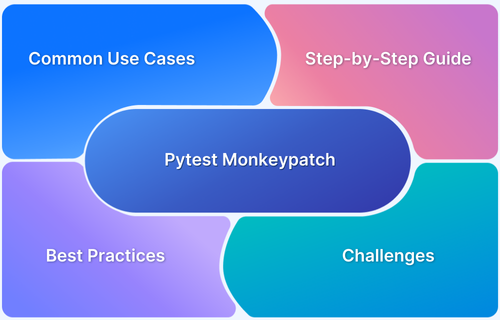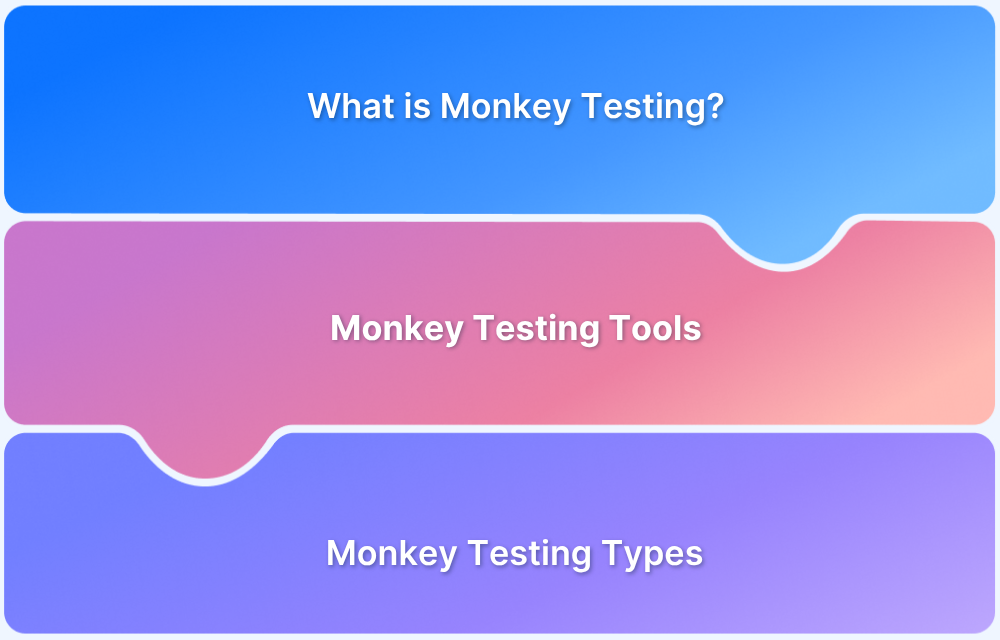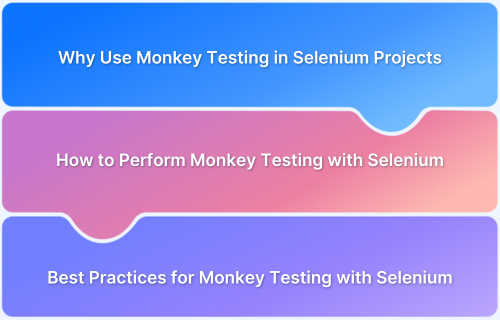Monkey patching modifies or extends libraries, classes, or modules while execution without updating the original code. It enables quick fixes and enhances third-party libraries, especially in test automation.
Overview
What is Monkey Patching?
Monkey patching modifies or extends libraries, classes, or modules at runtime without changing the source code. It is common in Python, Ruby, and JavaScript and enables quick fixes, overrides, and extensions.
Use Cases
- Fixing Bugs: Patch third-party libraries without modifying the source.
- Modifying Behavior: Customize built-in or external modules.
- Testing & Mocking: Replace methods to simulate dependencies.
- Feature Extensions: Add missing functionalities dynamically.
- Backward Compatibility: Adapt old libraries to new APIs.
Advantages
- Quick Fixes: Resolve issues instantly.
- Flexible & Extensible: Adapt third-party code easily.
- Great for Testing: Mock dependencies effortlessly.
- Supports Legacy Code: Extend outdated libraries.
Disadvantages
- Hard to Maintain: Alters original behavior, making debugging complex.
- Breaks on Updates: Patches may fail with library updates.
- Security Risks: Unintended modifications can introduce vulnerabilities.
This blog explores what monkey patching is, its use cases, advantages, disadvantages, and best practices, along with examples in different programming languages.
What is Monkey Patching?
Monkey patching is a dynamic technique in programming where you modify or extend the behavior of existing classes, modules, or functions at runtime. It’s called “monkey patching” because it’s often seen as a somewhat unconventional and potentially risky way to alter code, similar to how a mischievous monkey might tamper with things.
This approach involves the addition, modification, or replacement of attributes, methods, or functions within existing objects, enabling a high degree of flexibility in software development.
For example, developers can simulate different behaviors in testing environments by dynamically replacing functions or methods without needing to modify the underlying codebase. Such adaptability is particularly beneficial in scenarios requiring immediate changes, thereby supporting efficient development cycles and rapid iterations.
While this approach can be powerful, it is often controversial due to its potential risks and implications.
Read More: Understanding Monkeypatch in Pytest
Example of Monkey Patching
In Python, you can override a method of a class without altering its source code:
# Original class class Animal: def speak(self): return "I make sounds." # Monkey patching the speak method Animal.speak = lambda self: "I bark like a dog." # Usage animal = Animal() print(animal.speak()) # Output: I bark like a dog.
In this example, we redefine the speak method of Animal class at runtime. This changes the behavior of all instances of Animal class.
Read More: What is Monkey Testing
Use Cases of Monkey Patching
Monkey Patching finds its application in various scenarios, including:
- Fixing Bugs in Third-Party Libraries
Sometimes, third-party libraries contain bugs that developers cannot fix directly since they don’t have control over the source code.
Monkey patching allows temporary fixes to be applied without waiting for an official update or modifying the library files manually.
- Modifying Library Behavior
Developers may need to customize the behavior of built-in or third-party modules to meet specific requirements.
Monkey patching enables them to override methods or properties dynamically without altering the original source code. This is useful when a library lacks customization options.
- Testing & Mocking
In unit testing, it’s often necessary to replace or mock certain methods to isolate a function’s behavior.
Monkey patching allows developers to temporarily override functions, returning controlled responses without affecting the rest of the application. This is particularly helpful in dependency-heavy environments.
- Feature Extensions
If an existing library lacks a required feature, developers can use monkey patching to add new functionality. Instead of forking the library or waiting for the feature to be implemented by the maintainers, they can extend existing classes or functions dynamically.
- Ensuring Backward Compatibility
When working with legacy code, monkey patching can be used to modify outdated libraries to be compatible with newer APIs or systems.
This approach helps developers avoid complete rewrites while ensuring smooth transitions between different software versions.
- Quick Patching in Production
In critical production environments, immediate fixes may be required to address urgent issues. Deploying a full release can take time, so developers can use monkey patching to apply emergency fixes on the fly while preparing a permanent solution.
However, this should be done cautiously to avoid introducing further issues.
How Monkey Patching Works?
Monkey patching operates by directly altering classes, methods, or functions at runtime. By reassigning methods or attributes, developers can override the existing behavior, which immediately impacts all instances of the modified object. The essence of Monkey Patching lies in the ability to manipulate code on the fly.
By leveraging dynamic features of languages such as Python, developers can implement changes to classes or modules directly in memory.
For example, a developer might modify a third-party library to introduce a new functionality, like adding a metric to a testing library, without needing to alter the library’s codebase itself. This capability is especially useful for applying quick fixes or enhancements in scenarios where modifying the original code is impractical or impossible.
Read More: Monkey Testing with WebdriverIO
Monkey Patching in Different Programming Languages
Understand the implementation of monkey patching in various programming languages through the examples below.
Monkey Patching in Different Programming Languages:
- Python
- Ruby
- JavaScript
- PHP
Python
Python’s flexibility makes monkey patching relatively straightforward. The unittest.mock library is recommended for testing, but direct attribute assignment is also possible.
import unittest.mock
# Example using unittest.mock
def my_function():
print("Original function")
with unittest.mock.patch('__main__.my_function', return_value="Patched"):
patched_result = my_function()
print(f"Patched result: {patched_result}")
# Example with direct attribute assignment (less recommended for production)
class MyClass:
def my_method(self):
print("Original method")
original_method = MyClass.my_method
MyClass.my_method = lambda self: print("Patched method")
my_object = MyClass()
my_object.my_method()
MyClass.my_method = original_method # Restore original methodRuby
Ruby’s open classes allow for easy monkey patching. However, this can lead to unexpected behavior if not handled carefully.
class String alias_method :original_reverse, :reverse def reverse puts "Reversing string..." original_reverse end end puts "hello".reverse # Output: Reversing string...\n olleh # Restore original method (optional) class String remove_method :reverse alias_method :reverse, :original_reverse end
JavaScript
JavaScript also supports monkey patching, often by directly modifying prototype methods.
const originalReverse = Array.prototype.reverse;
Array.prototype.reverse = function() {
console.log("Reversing array...");
return originalReverse.apply(this);
};
let arr = [1, 2, 3];
console.log(arr.reverse()); // Output: Reversing array... [3, 2, 1]
// Restore original method (optional)
Array.prototype.reverse = originalReverse;PHP
PHP’s support for monkey patching is more limited than in Python or Ruby. Libraries like Patchwork can facilitate this, but it’s generally more complex. This example uses a simple function override, which is less powerful than patching class methods.
PHP doesn’t natively support direct function overrides. You need workarounds (like using closures or libraries such as Patchwork) to achieve monkey patching behaviour.
<?php
function myFunction() {
echo "Original function\n";
}
// Simulating function override with closure (Note: PHP doesn't natively allow direct function override at runtime)
$originalMyFunction = function() {
echo "Original function\n";
};
$myFunction = function() use ($originalMyFunction) {
echo "Patched function\n";
$originalMyFunction(); // Call original function
};
$myFunction(); // Output: Patched function\nOriginal function
?>Advantages of Monkey Patching
Monkey patching, while often frowned upon, does offer some niche advantages in specific situations:
- Flexibility and Rapid Prototyping: Monkey patching allows for quick modifications and extensions of existing code without altering the original source. This is particularly useful during rapid prototyping or experimentation with new features. Developers can test changes without committing to permanent code alterations.
- Testing and Mocking: Monkey patching is a valuable tool in unit testing and test-driven development (TDD). It enables the replacement of methods or modules with mock objects, isolating components for testing and creating controlled environments. This allows for more focused testing and easier debugging.
- Fixing Third-Party Bugs (with caution): In situations where modifying a third-party library’s source code is impossible or impractical, monkey patching can provide a temporary workaround to fix bugs or add missing functionality.
However, this is a risky approach and should only be considered as a last resort, with thorough documentation and testing. - Polyfills: Monkey patching is commonly used to create polyfills, which provide missing functionality in older browsers or environments that lack support for newer features. This ensures compatibility across different platforms.
Read More: What is Gorilla Testing: A Complete Guide
Disadvantages and Risks of Monkey Patching
The advantages of monkey patching are significantly outweighed by its considerable risks and disadvantages, especially in larger projects:
- Reduced Readability and Maintainability: Monkey patching makes code harder to understand and maintain. The modifications are not immediately apparent from the original source code, leading to confusion and difficulty in debugging.
- Increased Complexity and Debugging Challenges: The dynamic nature of monkey patching increases the complexity of the codebase, making it significantly more difficult to trace the flow of execution and identify the source of errors. Debugging becomes a nightmare.
- Unintended Side Effects and Conflicts: Monkey patching can lead to unexpected behavior and conflicts, especially when multiple patches modify the same code or when libraries are updated. This can result in unpredictable and difficult-to-diagnose errors.
- Testing Complexity: Testing code that uses monkey patching is significantly more challenging. The dynamic nature of the changes makes it difficult to ensure that all possible scenarios are covered by tests.
- Security Risks: In some cases, monkey patching can introduce security vulnerabilities, particularly if the patches are not properly vetted or if they are used to modify critical system components.
- Breaking Changes and Incompatibilities: Monkey patches can break when libraries or frameworks are updated, as the internal APIs they rely on may change. This can lead to significant problems and require extensive refactoring.
Read More: 20 Types of Tests Every Developer Should Run
Situations to avoid using Monkey Patching
Given the significant risks associated with monkey patching, there are numerous situations where it should be avoided entirely. In most cases, cleaner and safer alternatives exist that should be prioritized.
- Production Code: Monkey patching should never be used in production code. The unpredictable nature of runtime modifications makes it extremely dangerous in a live environment. The potential for unexpected behavior, conflicts, and security vulnerabilities is too high.
- When Source Code is Modifiable: If you have access to the source code of the library or module you want to change, directly modifying it is always the preferred approach. This ensures clarity and maintainability, and avoids the risks associated with monkey patching.
- Large Projects or Teams: In large projects with multiple developers, monkey patching dramatically increases the complexity and risk of conflicts. The lack of transparency and the potential for unintended side effects make it a recipe for disaster in collaborative environments.
- When Clear Alternatives Exist: Before resorting to monkey patching, always explore cleaner alternatives such as inheritance, composition, decorators, or dependency injection. These techniques offer structured ways to extend or modify functionality without the risks of monkey patching.
- When Upgrading Libraries: Monkey patches can easily break when libraries or frameworks are updated. The underlying APIs that the patch relies on may change, rendering the patch ineffective or even causing errors.
- When Code Clarity is Paramount: Monkey patching obscures the original intent of the code, making it harder to understand and maintain. This is especially problematic for future developers who may not be aware of the patches.
- When Security is Critical: Monkey patching can introduce security vulnerabilities, especially if it’s used to modify critical system components or if the patches are not properly vetted.
- When Long-Term Maintainability is a Priority: Monkey patches add to technical debt. They make it harder to track changes, understand the code’s behavior, and perform upgrades or refactoring. The long-term cost of maintaining monkey-patched code often outweighs any short-term gains.
Read More: What is Fault Injection in Software Testing?
Alternatives to Monkey Patching
Monkey patching, while offering flexibility, introduces significant risks to code maintainability and stability. Fortunately, several alternatives like Subclassing, Decorators, Dependency Injection, and Wrapper Classes offer structured ways to modify or extend functionality.
Alternatives to Monkey Patching:
- Subclassing
- Decorators
- Dependency Injection
- Wrapper Classes
Here’s a breakdown of the key approaches:
1. Subclassing
Subclassing is a fundamental object-oriented programming (OOP) technique where you create a new class (the subclass) that inherits attributes and methods from an existing class (the superclass).
You can then override existing methods in the subclass to modify their behavior or add new methods to extend functionality. This approach is clean and organized, and promotes code reusability.
Example (Python):
class SuperClass:
def my_method(self):
print("Original method")
class SubClass(SuperClass):
def my_method(self):
print("Modified method")
super().my_method() # Call the original method
subclass_instance = SubClass()
subclass_instance.my_method() # Output: Modified method\nOriginal method2. Decorators
Decorators provide a concise and elegant way to wrap functions or methods, adding functionality before or after the original code executes without modifying the original function’s source. This is particularly useful for adding logging, authentication, or other cross-cutting concerns.
Example (Python):
import functools
def my_decorator(func):
@functools.wraps(func) # Preserve original function metadata
def wrapper(*args, **kwargs):
print("Before function execution")
result = func(*args, **kwargs)
print("After function execution")
return result
return wrapper
@my_decorator
def my_function():
print("Original function")
my_function()
# Output: Before function execution\nOriginal function\nAfter function execution3. Dependency Injection
Dependency Injection (DI) is a design pattern where dependencies are provided to a class or function from the outside, rather than being created internally.
This allows for easy swapping of dependencies, facilitating testing and promoting loose coupling. Instead of directly modifying a class, you change its dependencies.
Example (Python):
class MyClass:
def __init__(self, my_dependency):
self.my_dependency = my_dependency
def my_method(self):
self.my_dependency.do_something()
class DependencyA:
def do_something(self):
print("Dependency A")
class DependencyB:
def do_something(self):
print("Dependency B")
# Use Dependency A
my_object_a = MyClass(DependencyA())
my_object_a.my_method() # Output: Dependency A
# Use Dependency B
my_object_b = MyClass(DependencyB())
my_object_b.my_method() # Output: Dependency B4. Wrapper Classes
Wrapper classes provide a way to encapsulate an existing object, adding functionality without modifying the original object’s code. The wrapper class delegates method calls to the wrapped object, adding pre- or post-processing logic as needed.
Example (Python):
class OriginalClass:
def my_method(self):
print("Original method")
class WrapperClass:
def __init__(self, original_object):
self.original_object = original_object
def my_method(self):
print("Before method call")
self.original_object.my_method()
print("After method call")
original_object = OriginalClass()
wrapper_object = WrapperClass(original_object)
wrapper_object.my_method()
# Output: Before method call\nOriginal method\nAfter method callMonkey Patching vs. Inheritance and Decorators
Monkey patching is different from inheritance and decorators. Inheritance creates new classes based on existing ones, while decorators modify functions in a more controlled and predictable way.
Monkey patching directly alters existing code at runtime. Know more about the key differences and best practices:
| Aspect | Monkey Patching | Inheritance | Decorators |
|---|---|---|---|
| Definition | Dynamically modifies or extends existing code at runtime without altering the original source. | Creates a new class based on an existing class, inheriting its attributes and methods, allowing for extension or modification. | Functions or classes that wrap another function or class to modify or extend behavior without changing the original code. |
| Use Cases |
|
|
|
| Advantages |
|
|
|
| Disadvantages |
|
|
|
| Best Practices |
|
|
|
Best Practices for Monkey Patching
When using monkey patching, it is essential to adhere to certain best practices to minimize risks and enhance maintainability.
Best Practices for Monkey Patching:
- Use Sparingly
- Keep Patches Localized
- Document Changes Clearly
- Ensure Comprehensive Testing
- Patch at Startup
- Stay Updated
- Evaluate Necessity
- Use Sparingly
Monkey patching should only be employed when absolutely necessary. Developers are encouraged to explore cleaner alternatives such as dependency injection or subclassing when possible, as over-reliance on monkey patching can lead to complex code that is hard to debug and maintain.
- Keep Patches Localized
Limit the scope of your monkey patches to avoid unintended side effects. By isolating changes to the smallest possible part of your codebase, you reduce the risk of impacting other functionalities and make the patches easier to manage.
- Document Changes Clearly
Comprehensive documentation is vital when implementing monkey patches. Developers should provide detailed comments explaining the rationale behind the patch and how it alters the original behavior. This practice improves maintainability and helps other developers understand the changes made.
- Ensure Comprehensive Testing
Testing is crucial when monkey patching to ensure that the modified behavior does not compromise the overall functionality of the application. Tests should cover edge cases and employ robust assertions to validate all expected outcomes. Integrating these tests into a continuous integration pipeline allows for regular checks and quicker identification of issues.
- Patch at Startup
Apply monkey patches early in the application lifecycle, ideally during initialization. This approach helps to prevent runtime surprises later in the code execution and ensures that all parts of the application utilize the modified behavior consistently.
- Stay Updated
Regularly monitor official updates or fixes to third-party libraries that might render your patches unnecessary. Keeping track of library changes not only helps to maintain code cleanliness but also ensures that you are using the most efficient and reliable solutions available.
- Evaluate Necessity
Before deciding to monkey patch, critically assess whether it is genuinely needed. In some cases, the need for monkey patching may indicate that the existing code requires refactoring instead.
How to Test Monkey Patch Functionality Effectively?
Monkey patching nonetheless poses challenges like unpredictability, debugging complexity, and maintenance overhead.
To effectively test monkey-patched code, isolate patches to minimize side effects, write comprehensive unit and integration tests, and implement regression tests to catch issues early. Use version control to track changes, document patches clearly for maintainability, and automate testing with frameworks like “pytest” to ensure consistency and efficiency.
BrowserStack Automate enhances this process by enabling cross-browser compatibility testing, parallel execution, and real-device testing to ensure patches perform reliably in diverse environments. Its CI/CD integration automates testing workflows, while detailed reporting simplifies debugging. Combining these best practices with BrowserStack Automate ensures your patches are robust, reducing risks and maintaining application stability.
Conclusion
Monkey patching offers a powerful way to modify behavior dynamically but should be approached with caution. While it provides flexibility and quick fixes, the associated risks make it unsuitable for all scenarios.
By understanding its advantages, disadvantages, and alternatives, developers can make informed decisions about when and how to use monkey patching.
As programming paradigms continue to evolve, the discourse surrounding monkey patching often juxtaposes it with alternative methods like inheritance and decorators, which can offer more structured approaches to modifying code.
This ongoing conversation underscores the need for developers to carefully evaluate the trade-offs of monkey patching, ensuring that its application aligns with project goals while maintaining code integrity and clarity.
FAQs
1. Is Monkey Patching a recommended practice in software development?
No, monkey patching is generally not recommended as a standard practice, especially in large or critical projects. It can lead to maintainability issues and unexpected behavior. Prefer cleaner alternatives like inheritance or composition whenever feasible.
While it’s not recommended for standard use, it can be valuable in some edge cases where no other solution is feasible.
2. What are the risks of Monkey Patching in large-scale projects?
In large projects, monkey patching increases the risk of:
- Unforeseen Side Effects: Patches can interact unexpectedly with other parts of the system.
- Debugging Difficulties: Tracing errors becomes significantly harder.
- Maintainability Challenges: Understanding and modifying the codebase becomes more complex.
3. How can I test monkey-patched functionality effectively?
Effective testing of monkey-patched code involves:
- Isolation: Test the patched functionality in isolation from other parts of the system.
- Mocking: Use mocks to simulate dependencies and control their behavior.
- Automated Testing: Use tools like BrowserStack Automate to automate tests across different environments.
4. Which programming languages support Monkey Patching?
Dynamically-typed languages like Python, Ruby, and JavaScript readily support monkey patching. It’s less common but still possible in languages like PHP.
5. Are there alternatives to Monkey Patching that offer similar flexibility?
Yes, alternatives include inheritance, composition, and decorators (in Python). These offer similar flexibility while improving code maintainability and reducing risks.
6. What are some real-world examples of Monkey Patching in use?
Monkey patching is sometimes used for:
- Extending third-party libraries: Adding functionality without modifying the original code.
- Debugging: Temporarily altering code behavior to isolate problems.
- Testing: Replacing dependencies with mocks during testing. However, this is often better handled with dependency injection.







